Background:
I have a condenser microphone, which requires +48V phantom power from my mixing desk. The microphone has a source impedance of "<200 Ohm" as per manufacturer. As you may recall, phantom power is delivered over both the "+" and "-" wires in the XLR connector, put on the wire with a 6.8 kOhm resistor pull-up on each wire. This means the maximum amount of current that can be drawn is about 14 mA (into a short) and more realistically < 10 mA. Some of this power is used by the built-in pre-amp in the microphone data sheet says 2.5 mA.
I've built an inline mute switch using a DPDT switch (rated for +48V DC) where the "mute state" switches the phantom power over to a blinking LED, reminding me I'm on mute.
Unfortunately, because this is a mechanical switch, AND because of the phantom power, switching on/off makes for loud pops. Given that I want the blinky-LED to consume some current when in the "mute" configuration, I probably need to switch off the pre-amp in the microphone to have enough current available -- and, anyway, I do need to turn off the signal from the microphone for it to be "muted."
With that background, I believe that I need to build some kind of active/solid state circuitry to mute/un-mute the microphone, turn on a blinking LED when it's muted, and still pass phantom power to the microphone. It's the last part that has me somewhat confused. Because the original source of the phantom power is already resistively protected with high impedance, how do I best re-buffer the signal, yet carry the phantom power forward without too much power loss?
I've considered extracting the common mode power with a center-tap transformer, and then using my own opamp to re-buffer the signal (which I can then turn off when needed) but this feels quite inelegant as I add another couple of high-resistance resistors in the path of the power. Yet, I don't know how to pass the power without also passing the signal any other way.
Here's an example sketch of what I have so far:
Microphone on the left, mixing desk on the right.
I'm looking for suggestions on how to better accomplish the separation of signal vs phantom power, ideally in a way that doesn't require adding more inline high-resistance resistors.
